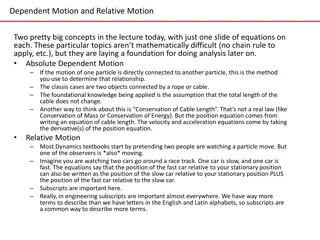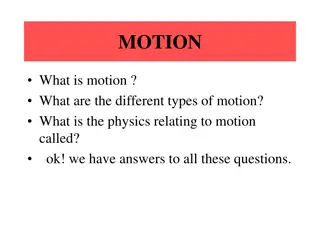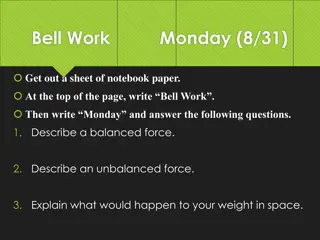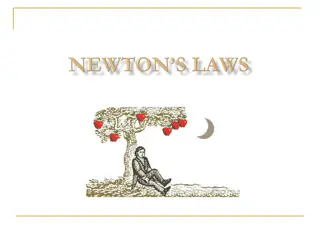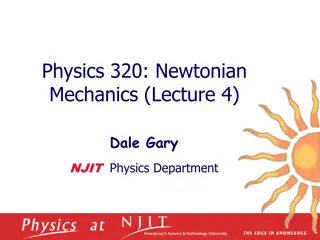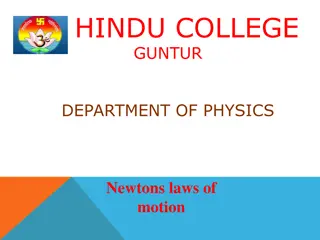Understanding Newton's Laws of Motion
Newton's laws of motion, formulated by Sir Isaac Newton, describe the interactions between forces and motion of massive bodies. The three laws cover inertia, force, acceleration, and action-reaction pairs, providing the foundation for understanding motion in various scenarios.
Download Presentation

Please find below an Image/Link to download the presentation.
The content on the website is provided AS IS for your information and personal use only. It may not be sold, licensed, or shared on other websites without obtaining consent from the author. Download presentation by click this link. If you encounter any issues during the download, it is possible that the publisher has removed the file from their server.
E N D
Presentation Transcript
Topic : Newton s Law of Motion And their Application Outline What are Newton s Law of motion Newton's first law of motion Newton s second law of motion Newton s Third law of Motion
Newtons law of Motion Newton s laws of motion, relations between the forces acting on a body and motion of the body, first formulated by English physicist and mathematician Newton(Sir Iassac Newton). Newton s three laws of motion describe the motion of massive bodies and how they interact. Newton's laws of motion can be applied in numerous situations to solve motion problems. Some problems contain multiple force vectors acting in different directions on an object. .
Newtons First law of Motion Newton's first law of motion - sometimes referred to as the law of inertia. An object at rest stays at rest and an object in motion stays in motion with the same speed and in the same direction unless acted upon by an unbalanced force.This simply means that things cannot start, stop or change direction all by themselves. It requires some force acting on them from the outside to cause such a change. While this concept seems simple and obvious to us today, in Newton's time it was truly revolutionary. Newton's first law says that if the net force on an object is zero ( F = 0 ), then that object will have zero acceleration. In other words, constat velocity at rest or constant non-zero velocity moving with a constant velocity. F=ma where a is acceleration and is eual to zero. Newton first law is also called law of Inertia. Law of inertia stated that if a body is at rest or moving at a constant speed in a straight line, it will remain at rest or keep moving in a straight line at constant speed unless it is acted upon by a force.
Newtons First law of Motion Example and Application of Newton s Law
Newtons second law of motion Newton's second law of motion pertains to the behavior of objects for which all existing forces are not balanced. The second law states that the acceleration of an object is dependent upon two variables the net force acting upon the object and the mass of the object. The acceleration of an object depends directly upon the net force acting upon the object, and inversely upon the mass of the object. As the force acting upon an object is increased, the acceleration of the object is increased. As the mass of an object is increased, the acceleration of the object is decreased. OR The acceleration of an object as produced by a net force is directly proportional to the magnitude of the net force, in the same direction as the net force, and inversely proportional to the mass of the object.
Newton third law of Motion Newton's third law is for every action, there is an equal and opposite reaction. The statement means that in every interaction, there is a pair of forces acting on the two interacting objects. The size of the forces on the first object equals the size of the force on the second object. For example, when you jump, your legs apply a force to the ground, and the ground applies and equal and opposite reaction force that propels you into the air. Because of Newton's Third Law. You hit the wall with a force, and that exact same amount of force is returned by the wall. While Rowing a boat, when you want to move forward on a boat, you paddle by pushing the water backwards, causing you to move forward.











